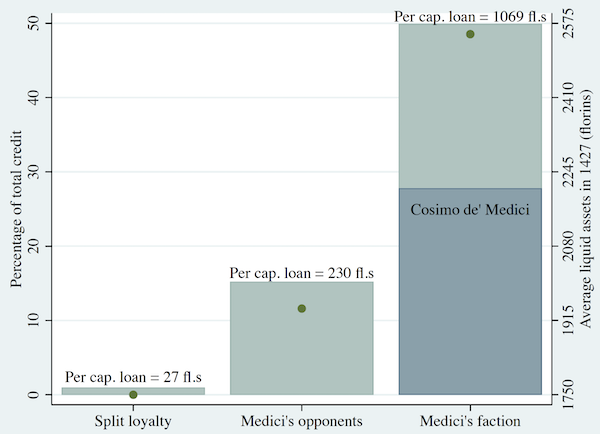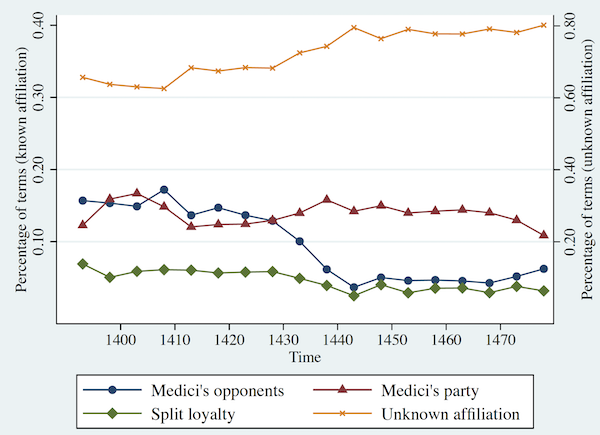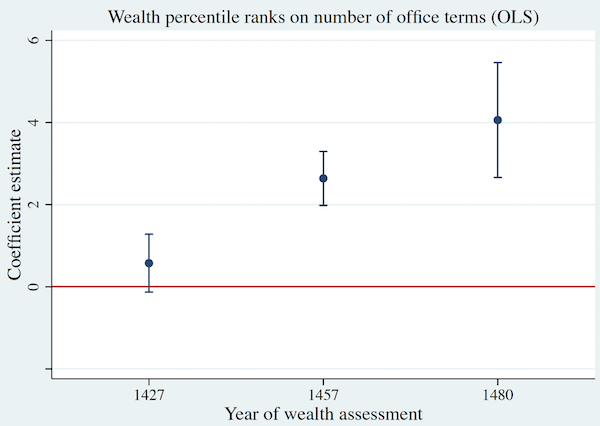Lambert here, speculating freely: The world-systems analyst Giovanni Arrighi argued (I paraphrase from memory) that the “center of gravity,” as it were, of capitalism moved in a spiral pattern from East to West, starting in Italy, then moving to the Netherlands, Britain, and the United States, and would in future move across the Pacific. Assuming he is correct, it would be an interesting comparative study to discover whether the patterns of state and civil society evolved to resemble those described here in Florence in each new center, as capital moved westward. Perhaps we have a political economist in the readership who can correct me.
By Marianna Belloc, Network member at Cesifo, Full Professor of Economics at Sapienza University Of Rome, Roberto Galbiati, CNRS Professor at Sciences Po Paris, and Francesco Drago, Professor of Economics at University of Catania. Originally publihshed at VoxEU.
The Medici family ruled Florence for nearly 300 years, patronising the arts and making Florence a cultural centre of Europe. But there was a dark side to Medici rule. This column studies the circumstances under which a relatively open political system can be corrupted by its confrontation with concentrated wealth. Without formally changing the constitutional architecture of the political system, the Medici machine manipulated its institutions and allowed political officials to appropriate public funds, transforming office holding from a civic duty to a source of individual wealth accumulation.
In September 1433, Cosimo de’ Medici, the founder of the Medici dynasty, was summoned to appear before the Signoria, the government of Florence, to be informed of his exile from the city. This decision resulted from the allegation that Cosimo had attempted to manipulate the outcomes of the selection process for government members. In response, Cosimo famously remarked: “Ask your soldiers how many times they were paid with my own funds, the Commune subsequently repaying me only when it was able to do so” (Molho 1971). Cosimo was one of the richest men in the city, the leader of a prosperous bank with branches all over Europe, and the main lender to the Republic in a period of high financial distress.
A year later, Cosimo was recalled to Florence. He took control of the city, marking the beginning of the Medici’s dominance, a rule would last in various forms for nearly three centuries. The political machine built by Cosimo, without formally changing the constitutional architecture of the political system, generated a systematic manipulation of its institutions and allowed a methodical appropriation of public resources by political officeholders. This historical episode occurred six centuries ago, yet its implications apply to present contexts, offering a warning about the circumstances under which relatively open political institutions, with checks and balances on political power, can be captured and profoundly altered when confronted with a strong concentration of wealth.
In the economics literature, the study of the effects of wealth concentration on politics has focused on various aspects within the broad spectrum of institutional capture. In their study of Venice, Puga and Trefler (2014) document how elites can formally shift institutions towards political closure; other scholars, such as Dal Bo (2006) and Glaeser et al. (2003), investigate how elites can influence institutions to work in their favour. Florence’s case lies between these two extremes: it shows how near-total political control can be achieved without formal institutional overturn and illustrates the consequences of this subtle yet profound form of institutional capture. It is emblematic of how political dynasties can arise and survive over time, a circumstance that might still be found in current democracies (Mendoza 2012).
In Belloc et al. (2022), we dig into this historical episode, documenting the mechanisms of institutional capture and the associated economic returns for elites, and explore its implications for wealth distribution.
The Republic of Florence was established in the 12th century. Between the first half of the 14th century and the end of the 15th century, access to city government was regulated by a system that mixed elections and selection by lottery. This system, called the Tratte, coupled with short term limits for officeholders, guaranteed comparatively broad participation in city government, ensured a relative balance of power across prominent families, and limited rent-extraction for several decades. The advent of Cosimo de’ Medici and his family to the political arena marked a breaking point.
Starting from the 1420s, the city participated in the Lombardy Wars, incurring massive military expenses. The pressure of the consequent fiscal crisis required substantial reform of the tax collection system, which involved broadening the tax base and establishing a mechanism for direct loans from citizens to the State. These events stimulated an increased demand for engagement in city government, but they also gave wealthy individuals the opportunity to become lenders to the Republic (Molho 1971). Among these lenders, Cosimo used his money to weave a network of patronage and credit relations (Padgett and Ansell 1993). Opposed by the leading families in the previous regime, the Medici exploited the bargaining power generated by their position as public debt holders and resource lenders to capture the political selection mechanism and seize control of the city. Figure 1 depicts the percentages of credit lent to the Republic by rival political factions between the 1420s and 1430s: it shows that the availability of movable wealth was strongly correlated with the contribution to public debt, and that the fraction of credit held by the Medici network was about half of all credit.
Figure 1 Loans to the Florentine Republic by political faction, 1427-1434

Notes: The bars (left vertical axis) measure the share of total credit provided as voluntary loans to the Republic between 1427 and 1432 by political affiliation. The dots (right vertical axis) denote the average liquid assets by political affiliation. Over each bar, the corresponding per capita loan is reported (in 1427 gold florins). The shaded area of the third bar refers to the share of credit provided by Cosimo and his son Lorenzo.
Source: Belloc et al. (2022).
Our study relies on a unique dataset compiled from archival and secondary sources, including wealth assessments of the universe of Florentine households in 1427, 1457, and 1480, as well as detailed information on family party affiliation and individual political participation over the 15th century.1
Relying on this dataset, we show that the Medici’s capture of Florentine political institutions involved manipulating the officeholder selection system to favour the members of their faction. After the Medici rose to power, being a member of their faction correlated with the probability of being elected to public office, while the chances of the Medici’s political opponents diminished. Figure 2 illustrates the relative frequencies of office terms by political affiliation and five-year intervals over the period of interest. As can be seen, while the political presence of individuals with split loyalties remains roughly stable over the century, the presence of individuals close to either the Medici or their opponents dramatically diverge after the end of the 1420s.
Figure 2 Relative frequencies of office terms by political affiliation and five-year intervals

Notes: The lines show the relative frequency of office terms by party and five-year intervals. The left (right) vertical axis refers to individuals with known (unknown) affiliation.
Source: Belloc et al. (2022).
Our data also allow us to track how political participation correlated with changes in individual wealth over time. As depicted in Figure 3, before the Medici rose to power, the number of terms an individual spent in office (measured in the period 1393–1426) was not significantly associated with individual wealth accumulation (1427). By contrast, after the Medici took control of the political system, the correlation between office holding (1427–1456 and 1457–1480) and wealth (respectively, 1457 and 1480) increased substantially.
Figure 3 Political participation and individual wealth position

Notes: The graph plots OLS estimated coefficients from a regression of individual wealth (1427, 1457, and 1480) on individual terms in office (respectively, 1393–1426, 1427–1456, and 1457–1480), the vertical lines indicating confidence intervals at the 95% level.
Source: Belloc et al. (2022).
The data represented above and the results of other empirical exercises in the paper suggest that the Medici’s institutional capture transformed active political participation into a vehicle for personal enrichment. Nor was this system innocuous for the overall distribution of wealth. In fact, while political institutions remained formally unchanged, hundreds of individuals who participated in city government saw their wealth increase with each term in office. We find that the concentration of wealth at the top of the distribution increased after the Medici consolidated their power, as the dynamics of wealth accumulation favoured families affiliated with the Medici more than families outside their network.
We identify two primary mechanisms through which political officeholders might have extracted rents under the Medici: the direct appropriation of public resources and the use of their political role to leverage networks of patronage for personal gain (Padget and Ansell 1993). Public resource appropriation and patronage, while difficult to document, are not uncommon in contemporary political contexts (Prem et al. 2019, Labonne and Fafchamps 2016). Public officials aligned with the Medici were able to exploit their positions to secure favourable loans, contracts, and other financial advantages. In our paper, we show that during the Medici’s regime, and not before, the Republic paid higher interest rates to households holding larger numbers of office terms.
We conclude that the Medici’s capture of Florentine political institutions had significant economic consequences. Political office holding in 15th-century Florence had long been a position of civic duty with little personal economic return; under the Medici’s regime, it became a source of individual wealth accumulation. This transformation contributed to greater wealth inequality, which in turn further enriched a political faction at the expense of civil society. The Medici were protectors of the arts and contributed to making Florence one of the most important cultural, economic, and political centres of Europe. This is the main reason their name remains famous around the world. However, as we show, the Medici’s legacy is also associated with the personal use of public office and perpetuation of inequality. What happened under their regime resembles many situations that could be found today, in which economic and political power intertwine, generating vicious circles of wealth inequality and abuse of public office.


Concentration of wealth always leads to corruption, which is why Healthy cultures avoid corruption by avoiding concentration of wealth. Cultures that don’t have corruption have economies that reward generosity rather than profit/hoarding, and thus their leaders are the most generous rather than the most selfish.
This video gives examples – Myth: Capitalism is the Root Problem
Endless scholarship keeps telling us the same thing: that having rich people leads to political corruption. The challenge is how to transition to a culture that rewards sharing, which is how every human culture worked until recent centuries. I’m only aware of one successful revolution in recent decades where people made such a transition and built a culture without corruption and rich and poor.
This is just patently false. Have you cracked open a history book recently?
I think that by “until recent centuries”, Hickory meant “until the Bronze Age.” That at least seems to be the gist of the linked video. I think the video says that the problem is greed and that generosity is somehow the cure.
Many are still searching for the Noble Savage. He has never existed, and, even if he did, we can never go back.
Yes, everyone at all times was just like us! Except when they were (and are) not. An example: https://en.wikipedia.org/wiki/%C7%83Kung_people
All evidence is that we will go back within a decade or so, albeit involuntarily and ignobly.
Thank you, Lambert.
Readers may also be interested in how the wealthy from medieval Florence are still wealthy:
https://www.vox.com/2016/5/18/11691818/barone-mocetti-florence and
https://www.thelocal.it/20160818/the-richest-families-florence-1427-wealth-hereditary-social-mobility-italy
East to West, no? Westward, not eastward?
[family blogging] dyslexia. Fixed.
The U.S. has had so many Medici dynasties: Rockefellers, Sacklers, Kochs, Fricks, Carnegies, Fords… way too many to list. Criminal syndicates, every single one of them. Bezos, Zuckerberg, Gates and Musk are just johnny-come-latelies.
At least Bezos’ ex seems to have a conscience…
One unique feature of USA was individual ownership of mineral rights whereas in Europe they were property of monarch or state. This is why Samuel built up Shell in Mexico and D’Arcy ran concessions in Persia to create BP
Huge concentration of huge wealth became possible in U.S. with first Trusts to incorporate it then the use of Foundations as in Rockefeller and Ford to perpetuate it and spread into every area of life
Thanks for a good thought, Mike Liston
How to make an Oligarchic Republic….eh?! Probably something very familiar with those living in the Roman Republic, 1800 years prior. Catilina wanted a Jubilee…
One need only look at how penniless grifters like the Clintons and Obamas have enriched themselves through post-office “foundations” and “book deals” in a breathtaking wave of corruption after dismantling New Deal financial regulation and non-prosecution of the perpetrators of the GFC.
But the Supremes say this post facto pay-off syndicate isn’t “bribery” because no direct quid pro quo.
How much money do these people really need?
I have no doubt Barry Seal could explain just how “enriched” Clintons were by Mena airport but since he – like Vince Foster – is very dead……..and Tom Cruise respectfully omitted certain matters from his movie……..
Well, what seems to me unique is how the Medicis were able to parlay their financial empire into a hereditary Duchy and then take over the Catholic church. As the Medici Pope Clement VII decided to support Charles V against Henry VIII in the matter of Henry’s wife (and Charles’ aunt) he fostered the schism of the church. (Henry for his part recognized that a repeat of the War of the Roses over succession would be ruinous for England.)
My understanding was that Charles V as Holy Roman Emperor besieged the Pope to get his way. In fact it was a papal nuncio who was acceding to Henry’s request for an annulment that was recalled,
Charles V had already sacked Rome and held the pope hostage in 1527 after defeating League of Cognac – but he had forgotten to pay his 14,000 soldiers and they rampaged
I think it would be interesting to wonder whether it will take 600 years before we have a historian capable of making the kind of assessment of political-financial corruption in the contemporary world which this historian makes in fifteenth-century Italy.
Mark you, in 600 years such a historian probably wouldn’t be human.
Looking at power dynasties, in the UK we have the Harmsworth family. IIRC the first head of the dynasty Lord Northcliffe founded the Daily Mail c.1895. The family still owns it though the head of the family is now Lord Rothermere, the descendant of Northcliffe’s brother. Funnily enough the man reportedly benefits from non-domiciled status (therefore largely exempt from income tax and inheritance tax), though it is conceivable the Labour government might actually take this away from him, which, as the Mail is virulently ant–Labour, they can do without adding any serious extra enemies to those they have already.
Interestingly, Northcliffe befriended, during WW1, a young journalist called Keith Murdoch, father of Rupert. As Rupert now owns the other most important UK tabloid, the Sun, the families are still effectively political allies in many respects a hundred years later. Both supported Brexit which did much to increase their power in the UK (though the decline of the printed press is of course working in the other direction).
A Victorian journalist, William Thomas Stead, coined a phrase which IMO resonates to this day: ‘Government by Journalism’ (i.e. press barons).
So some things change, but a lot does not.